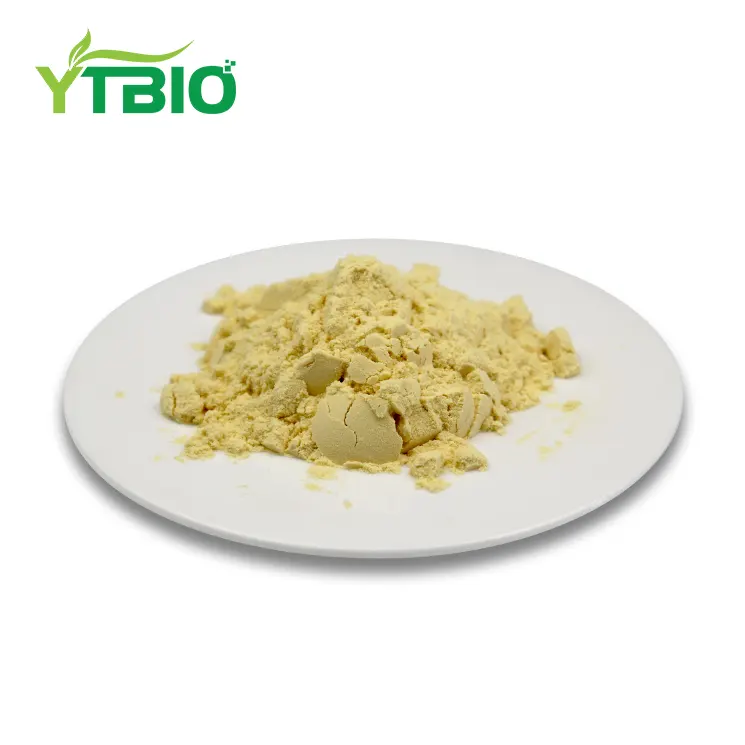Aloin Powder
Detection method: HPLC
Source: Aloe Vera
CAS:1415-73-2
Molecular formula: C21H22O9
Molecular weight: 418.39
EINECS:215-808-0
Shipping speed:1-3 days
Inventory:In stock
Certificates:HACCP, HALAL, KOSHER, ISO9001, ISO22000, FDA
MOQ:25KG
Package:25Kg/barrel
Sales group:not for individual customers
- Fast Delievery
- Quality Assurance
- 24/7 Customer Service
Product Introduction
What is aloin?
Aloin powder is a chemical substance extracted from the aloe plant. It is rich in nutrients and has rich medicinal effects. Aloe glycoside is widely used in medicine and health supplements and has been proven to have a variety of benefits for human health. This article will introduce in detail aloin, a chemical substance extracted from the aloe plant, which is rich in nutrients and has rich medicinal effects. Aloin is widely used in pharmaceuticals and nutraceuticals and has been shown to have a variety of benefits for human health.
Aloe glycoside is a natural organic compound with the English name Aloin or Barbaloin and its molecular formula is C21H22O9. It crystallizes into yellow needle crystals in ethanol. Easily soluble in water, pyridine, glacial acetic acid, formic acid, acetone, methyl acetate and ethanol. It is the concentrated and dried juice of the leaves of the monocotyledonous Liliaceae plants Aloe barbadensis Miller, Aloe ferox Miller or other closely related plants of the same genus (such as Aloe vera). It has physiological effects such as purgative effect, depigmentation effect, tyrosinase inhibition, free radical scavenging effect and antibacterial activity. Toxicology research in vitro tests can cause gene mutations in bacteria and mammalian cells. The part that has caused controversy in terms of food safety is anthraquinone laxatives represented by aloe glycoside. The Chinese health food review requires that the daily recommended amount of aloe glycoside products should not exceed 2g. Aloe glycoside can be stored in a relatively stable environment: temperature 15°C, protection from light (solid state) and acidic environment with pH=1 (liquid state).
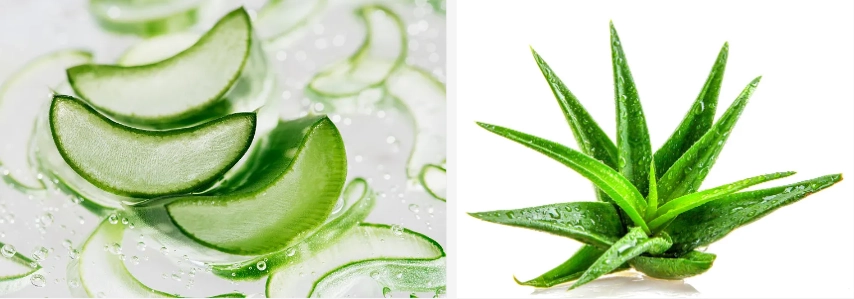
Chemical properties
Easily soluble in pyridine, glacial acetic acid, formic acid, acetone, methyl acetate, ethanol, etc. Derived from dicotyledonous plant Liliaceae plants, Aloe vera Aloevera L, Aloe vera Aloeferox Mill, and Aloe vera extract. Aloin is a natural substance found in various aloe plants. Aloe glycoside was originally used as a laxative to treat constipation. Recent studies have shown that aloin enhances melanin production and transglutaminase activity.
What are the benefits?
1. Anti-inflammatory effect
It has obvious anti-inflammatory effects and can inhibit the activation of inflammatory cells and the release of inflammatory mediators. Studies have shown that aloe glycoside can reduce the adhesion and activation of leukocytes, inhibit the synthesis of inflammatory mediators, and regulate the signaling pathways of inflammatory responses. Therefore, aloin can be used to treat various inflammatory diseases, such as rheumatoid arthritis, enteritis, malaria, and acne.
2. Antibacterial effect
Aloin powder has inhibitory and killing effects on a variety of bacteria and fungi. Studies have shown that aloe glycoside can inhibit bacterial growth by destroying bacterial cell walls, interfering with bacterial metabolism and inhibiting bacterial growth. At the same time, aloe glycoside can also enhance the body's immunity to antibacterial infections and improve the body's resistance to death caused by bacterial infections. Therefore, aloin can be used to treat various bacterial and fungal infections.
3. Protect the liver
Aloe glycoside protects the liver from chemical and drug damage. Studies have shown that aloe glycoside can reduce the oxidative stress state of the liver, inhibit liver fibrosis and bile synthesis, promote the regeneration of liver cells, and improve liver function. Therefore, aloe glycoside can be used to treat liver diseases such as hepatitis, cirrhosis and liver fibrosis.
4. Antioxidant effect
It has obvious antioxidant effects, can remove free radicals in the body and reduce oxidative stress damage. Studies have shown that aloe glycoside can increase the body's antioxidant enzyme activity, enhance the antioxidant defense system, inhibit the generation of oxygen free radicals, and reduce the accumulation of lipid peroxidation products. Therefore, aloe glycoside can be used to prevent and treat oxidative stress-related diseases, such as heart disease, cancer, and Alzheimer's disease.
5. Lowering blood sugar and blood lipids
It can lower blood sugar and blood lipids, and has certain curative effects on patients with diabetes and hyperlipidemia. Research shows that aloe glycoside can promote the secretion of insulin, enhance the insulin effect of glucose, and reduce blood sugar levels. At the same time, aloe glycoside can also inhibit fat synthesis and cholesterol absorption, and reduce blood lipid levels. Therefore, aloe glycoside can be used to treat metabolic diseases such as diabetes and hyperlipidemia.
In summary, aloe glycoside has a variety of effects and effects, including anti-inflammatory, antibacterial, liver protection, antioxidant, hypoglycemic and hypolipidemia, etc. Therefore, aloe glycoside has broad application prospects and is of great value in the fields of medicine and health care products. However, it should be noted that since each person's physical condition and needs are different, when using aloe vera glycoside, you should consult a doctor or professional for advice based on the specific situation, and use it in the correct dosage.
In vitro studies
Aloin, a natural anthracycline extracted from aloe vera, is a tyrosinase inhibitor with an inhibition rate of 2mM. Aloin exhibits significant anti-proliferative effects at physiological concentrations (IC50=97μM), causing cell cycle arrest in the S phase and significantly increasing HeLaS3 cell apoptosis (to 24%). In the MCF-7 cell line, Aloin caused a decrease in the proportion of cells in the mitotic phase by inducing apoptosis, inhibited the expression of topo IIα protein, and down-regulated the expression of cell cycle B1 protein.
Results and discussion
Toxicity of aloin to HepG2 cells
The potential effect of aloin on cell viability was detected by MTT. The results showed that aloin concentrations up to 500 μg/mL did not damage cell integrity, while concentrations above 750 μg/mL reduced cell viability (Figure 1a).

Figure 1 Cell viability (a); Effect of aloin on glucose consumption in HepG2 cells (b); Effect of aloin on HK and PDH activities in HepG2 cells (c)
Effect of aloin on glucose consumption in IR-HepG2 cells
As shown in Figure 1 b, DEX significantly inhibited glucose consumption, while treatment with 10–200 μg/mL aloin could significantly increase glucose consumption of IR-HepG2 cells in a dose-dependent manner. The effect of aloin on IR at doses of 100 and 200 μg/mL was comparable to that of metformin at a concentration of 1.5 μmol/L, indicating that aloin has potential hypoglycemic effects.
Aloe glycoside increases the activities of HK and PDH in IR-HepG2 cells
HK and PDH are key rate-limiting enzymes in glycolysis. Aloin at 50 and 100 μg/mL significantly increased the activities of HK and PDH (P < 0.05, Figure 1c). HK increases hepatic glycogen content and glucose utilization for energy production. Treatment of T2DM is accompanied by an increase in hepatic pyruvate dehydrogenase complex activity. Activation of PDH, the first enzyme of the pyruvate dehydrogenase complex, alleviates insulin resistance.
Effects of aloin on body weight and FBG levels in T2D mice
Changes in body weight were measured on days 0, 14 and 25 of treatment (Fig. 2a). The body weight of T2D mice in the model group, metformin group and aloe glycoside group was significantly lower than that of the mice in the normal group. Diabetic mice lost weight compared to non-diabetic controls. Body weight in the metformin treatment group decreased after 14 days of administration and then remained stable. In addition, the body weight of diabetic mice in the aloe glycoside group decreased slightly. FBG levels are the most widely used test to detect diabetes and reflect basal insulin secretion and pancreatic beta-cell function. Figure 2b shows the effect of aloin treatment on FBG levels in T2D mice on different days. The results showed that the FBG levels of obese mice in the model group increased sharply, indicating that the mouse model was successfully established. After two weeks of treatment, the FBG levels in the metformin and aloe glycoside treatment groups decreased compared with the model group (P < 0.05). In addition, the FBG level in the aloin group reached nearly 11.1 mmol/L on day 14, which was comparable to the metformin treatment group.
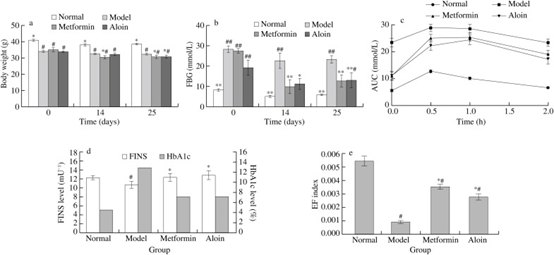
Figure 2 In vivo effects of aloin on body weight (a), FBG level (b), AUC (c), FINS and HbA1c levels (d), and EF index (e)
Effect of aloin on OGTT in T2D mice
The OGTT is an important indicator of diabetes severity. The effect of aloin on glucose tolerance in T2D mice is shown in Figure 2c. The glucose tolerance of the mice in the model group was severely impaired, and the blood glucose level at 0 h was significantly higher than that of other groups, and increased rapidly within 30 min. The AUC of glucose in the model group, metformin group and aloe glycoside treatment group were 53.37, 43.92 and 40.78 respectively, which were significantly greater than 18.59 in the normal group (P < 0.01). However, compared with the model group, the AUC of the aloe glycoside treatment group and metformin group were significantly lower (P < 0.05). These results indicate that aloin can improve impaired glucose tolerance in T2D mice.
Effects of aloin on FINS and HbA1c in T2D mice
The percentage of glycated hemoglobin (HbA1c) is equal to the ratio of HbA1c concentration to total hemoglobin (Hb) and is used to accurately verify staged diabetes. After STZ injection, the FINS level of T2D model mice was significantly lower than that of normal mice (P < 0.05). In STZ-induced T2D mice, FINS levels were significantly increased after aloin treatment (P < 0.05), which was similar to the effect observed in the normal group (Fig. 2d). The ELISA results showed that compared with the normal group, the HbA1c level in the model group was significantly increased (P < 0.01). In contrast, the HbA1c levels observed in the aloin-treated group were lower than those in the model group. Therefore, aloin can improve blood sugar levels to a certain extent.
Effect of aloin on epididymal fat index in T2D mice
The epididymal fat (EF) index was evaluated in this study (Fig. 2e). The model group decreased, but metformin and aloe glycoside treatment effectively increased it. This result shows that aloin can promote the conversion of glucose into lipids and inhibit insulin resistance.
Effects of aloin on liver histopathology in T2D mice
As shown in Figure 3. Liver tissue sections from normal mice showed normal histological structure with no cell rupture, uniform distribution, and intact hepatocytes (Fig. 3a). The model group had central vein dilation, local hepatocyte necrosis, inflammatory cell aggregation, congestion, etc. (Figure 3b). Furthermore, histopathological staining of liver tissue sections from T2D mice was deeper than that from normal mice. Extensive hepatocyte vacuolization was observed in HFSD-fed mice, suggesting accumulation of fat in liver tissue. However, aloin and metformin treatment significantly improved these histopathological changes and inflammation in diabetic mice, resulting in relatively normal liver structure (Fig. 3c, 3d).
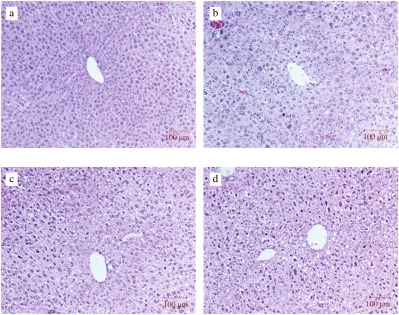
Figure 3 Histological analysis of T2D mouse liver (a) normal group, (b) model group, (c) metformin group, (d) aloin group
Alpha diversity of microbial 16srRNA genes
To identify taxa unique to different taxa, operational taxonomic units (OTUs) were clustered and partitioned using Venn plots, with clustering reaching 97% sequence similarity. A total of 1 145 OTUs were identified in all groups (Fig. 4). In addition, 873, 922, 775, and 637 OTUs were observed in the normal group, model group, metformin group, and aloe glycoside group, respectively. Among them, the model group had the highest abundance of intestinal flora and the aloe glycoside group had the lowest. In addition, there were a total of 496 OTUs in the 4 mouse groups, and a total of 105 OTUs in the normal, metformin, and aloe glycoside-treated groups. 164 and 213 unique OTUs were observed in the normal group and model group, respectively (Fig. 4b), indicating differences in the microbiota between normal and T2D mice. In contrast, there were only 35 and 15 OTUs in the metformin group and aloin group, respectively (Fig. 4a).

Figure 4 Venn diagram (a) of OTU distribution in normal (blue), model (green), metformin (red) and aloin (purple) groups. Compare the OTUs between the normal group and the model group (b), the normal group and the metformin group (c), the normal group and the aloe glycoside group (d), the metformin group and the aloe glycoside group (e)
Effect of aloin on intestinal flora of T2D mice
Metabolic disorders such as diabetes are closely related to changes in the intestinal microbiota. Aloin is able to reshape STZ-stimulated intestinal microbial imbalance by reducing the elevated Firmicutes/Bacteroidetes ratio. At the same time, after aloin treatment, the abundance of GCA-900066575, Lachnospiraceae_UCG-006, Firmicutes A2, Prevotellaceae UCG-001, Bacteroidetes and Bacteroidetes genera was significantly Increase.

Figure 5 Effects of aloin on the intestinal microbiota and abundance of different groups of T2D mice at the phylum level (a) and genus level (b); community distribution map of genus-level species evolutionary tree samples (c)
Effect of aloin on JNK/IRS1/PI3K/AKT signaling pathway
Western blot experiments were performed to evaluate the hypoglycemic effect of aloe through the JNK/IRS1/PI3K/AKT signaling pathway. The expression of JNK protein increased rapidly in the model group, thus triggering insulin resistance (Figure 6). Compared with the model group, the aloe glycoside group significantly inhibited the expression of JNK protein. At the same time, the expression of IRS1/PI3K/AKT protein was significantly increased after treatment with aloin.
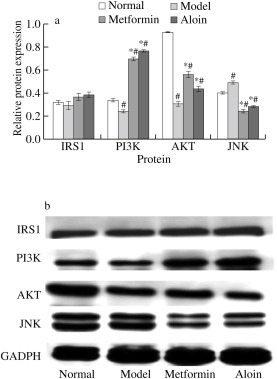
Figure 6 Effect of aloin on expression of IRS1, PI3K, AKT and JNK in liver
Aloin supplier
Yuantai Organic Bio is committed to providing customers with the highest-quality bulk Aloin Powder and services so that every consumer can enjoy natural, healthy, and high-quality food. If you have any inquiries or needs about our products, please feel free to contact us, and we will reply to you as soon as possible.

_1737093401309.png)
